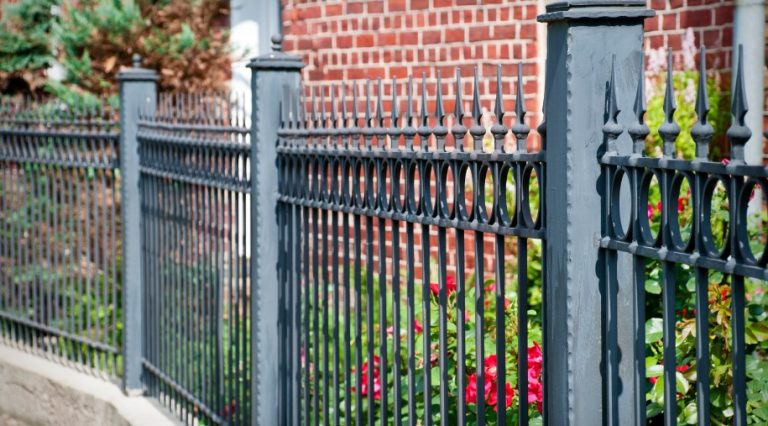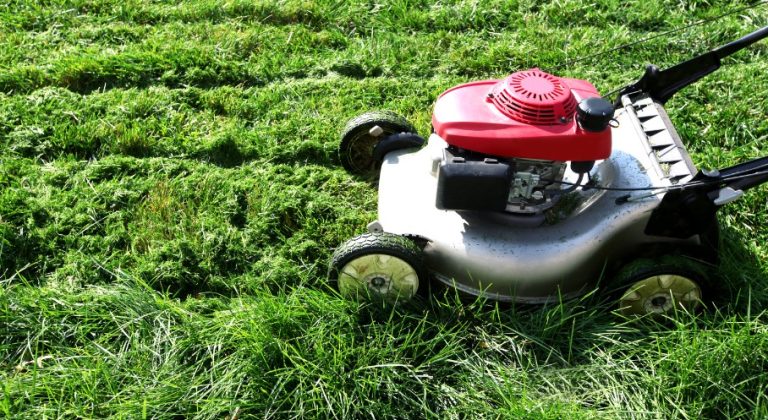Boundary walls are essential in maintaining clear property lines and ensuring privacy between neighbouring homes. When these walls collapse—whether from natural causes like storms, structural wear, or lack of maintenance—it can lead to significant confusion and disputes over who should be responsible for the repairs.
The issue is particularly complex in the UK, where boundary laws, property ownership, and legal frameworks like Party Wall Agreements come into play.
Understanding your rights and responsibilities regarding a boundary wall collapse is crucial for avoiding costly repairs, strained neighbourly relations, and even potential legal action.
This article provides a thorough breakdown of the legal and practical aspects surrounding boundary wall collapses, focusing on the situation in the UK and specifically England.
What is the Boundary Ownership?
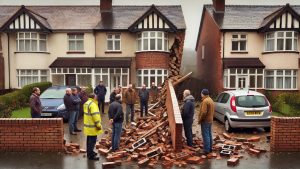
The first step in determining responsibility for a collapsed boundary wall is to establish who owns the wall. In the UK, boundary ownership is not always straightforward, and in some cases, property boundaries can be unclear or disputed. However, certain legal documents can help clarify ownership:
- Property deeds and title plans: These documents are critical in determining who owns a boundary wall. If the wall falls entirely within your property, you are likely responsible for its upkeep. These documents are available from the Land Registry and usually indicate boundaries with a “T” mark. A “T” on your side of the boundary indicates that you are responsible for the maintenance of that wall or fence on the property.
- Shared boundaries: If the property deeds or title plan show a “T” mark on both sides of the boundary, forming an “H” symbol, it typically indicates a shared boundary, meaning both neighbours have equal responsibility for the wall. This situation is often referred to as a “party wall.”
- Historical ownership disputes: If the wall’s ownership isn’t clear, or if there has been a long-standing assumption about responsibility that isn’t officially documented, it’s essential to review these legal papers or seek advice from a property lawyer. Ignoring this step can lead to disagreements with neighbours down the line, especially when repairs or maintenance are required.
Boundary Wall Collapse: Who is Responsible in England?

If a boundary wall collapses, understanding who bears the responsibility for repairs depends largely on the specific circumstances and the legal framework in place.
- Walls entirely on one property: If the collapsed wall is entirely within the boundary of one property, the responsibility for its repair lies with the property owner. They will need to arrange for the repair and cover the costs. In cases where the collapse has caused damage to neighbouring properties or created safety hazards, the responsible homeowner must address the issue promptly to avoid potential legal action from the affected neighbour.
- Shared or party walls: A common scenario is when a boundary wall lies between two properties and is considered shared (a party wall). In these cases, both neighbours have a shared responsibility for the upkeep and repair of the wall. The Party Wall etc. Act 1996 governs such shared boundaries, setting out clear guidelines on how responsibilities should be managed. If a shared wall collapses, both parties typically need to agree on a repair solution and divide the costs. This can sometimes lead to disagreements, especially if one party is unwilling to contribute or disputes the cause of the collapse.
- Causes of the collapse: The cause of the collapse is also crucial in determining responsibility. For example, if the wall collapses due to a natural event like a severe storm, neighbours may need to agree on shared repairs, particularly if both properties are affected. On the other hand, if the collapse is due to neglect or poor maintenance by one party, that party may be held solely responsible for the repairs.
Legal Framework: Party Wall Agreements and UK Property Laws
When a boundary wall collapse involves a shared structure, a Party Wall Agreement becomes an essential document. This legal agreement is particularly useful for ensuring that both property owners understand their obligations concerning shared walls or structures.
What is a Party Wall Agreement?: A Party Wall Agreement is a legal document that outlines the responsibilities of neighbouring property owners regarding shared walls. It’s typically drawn up when construction or renovation work could potentially impact the shared boundary. The agreement serves to protect both parties’ interests, ensuring that both understand their legal obligations to maintain or repair the wall.
If a Party Wall Agreement is in place, it will usually specify which neighbour is responsible for maintaining the wall or if the repair costs should be shared equally. In the case of a collapsed boundary wall, the agreement will provide a clear path to resolving disputes over repair responsibilities.
The Party Wall etc. Act 1996: This Act governs disputes involving party walls, boundary walls, and other shared structures in England and Wales. It aims to provide a clear legal framework for resolving disputes that arise when work is carried out on or near shared walls. Importantly, if there is no Party Wall Agreement in place and the wall collapses, the Act provides a mechanism for resolving disputes between neighbours.
Property owners are encouraged to have a Party Wall Agreement in place before undertaking any work that might affect shared walls, such as extensions or major renovations. If no agreement exists, it may still be possible to resolve the issue through negotiation or mediation, but legal advice is often necessary in such cases.
Neighbours’ Boundary Wall Falling Down: Who Pays for Repairs?
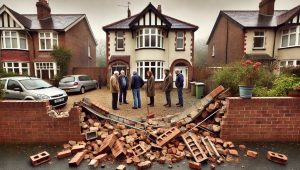
When a neighbour’s boundary wall collapses, it’s natural to wonder who is responsible for the repairs, especially if the collapse impacts both properties. The answer depends on a variety of factors:
- Sole ownership of the boundary: If the boundary wall belongs solely to your neighbour (as shown by property deeds), then they are likely responsible for the repairs. However, the situation can become more complicated if the collapse causes damage to your property, as your neighbour could be liable for the damages if the collapse was due to their negligence.
- Shared boundary responsibility: If the wall is a shared boundary, both parties are typically expected to contribute to the repairs. The specific terms of repair responsibility should ideally be covered in a Party Wall Agreement, but in its absence, you and your neighbour will need to negotiate a solution. In many cases, dividing the cost of repairs equally is a fair resolution.
- Disputes over responsibility: If you and your neighbour cannot agree on who is responsible for the repairs, you may need to seek mediation or even legal advice. Solicitors specialising in property law can help clarify legal responsibilities and suggest possible solutions.
How to Resolve Boundary Wall Disputes with Neighbours?
Disputes over boundary walls can arise easily, especially when the wall collapses and there is uncertainty over repair responsibility. However, there are several steps you can take to resolve these disputes without resorting to legal action:
- Open communication: The first step is to talk to your neighbour calmly and openly. Many disputes can be resolved through direct communication, with both parties agreeing on a fair solution.
- Review legal documents: Check the property deeds, title plans, and any Party Wall Agreements that may apply. This can clarify who is legally responsible for the wall’s upkeep and repair.
- Mediation services: If communication doesn’t resolve the issue, consider hiring a mediator. Mediation services can help neighbours reach a fair agreement without involving the courts.
- Legal action: As a last resort, if the dispute cannot be resolved through communication or mediation, you may need to take legal action. This could involve hiring a solicitor to represent your case in court. However, this option can be time-consuming and expensive, so it should be avoided if possible.
What Are the Boundary Wall Rules and Responsibilities in the UK?
In the UK, there are specific rules governing the construction, repair, and alteration of boundary walls. When dealing with a collapsed boundary wall, it’s important to understand these boundary rules to ensure that any repair or rebuilding work complies with local regulations.
- Planning permission: If you plan to rebuild or significantly alter a boundary wall, you may need to apply for planning permission. This is especially true if the wall is higher than 2 metres or if the property is located in a conservation area. Your local council can provide guidance on whether planning permission is required for your project.
- Listed properties and conservation areas: If your property or the boundary wall is part of a listed building, there may be additional restrictions on what repairs or alterations can be made. Conservation areas also have special rules aimed at preserving the character of the area, and you may need to follow specific guidelines when repairing a boundary wall in such locations.
- Building regulations: In some cases, repairing or rebuilding a boundary wall may be subject to building regulations. These regulations are designed to ensure that any construction work meets safety and structural standards. Before starting any major repairs, it’s a good idea to check with your local council to see if building regulations apply.
Cost-effective Solutions for Boundary Wall Collapse
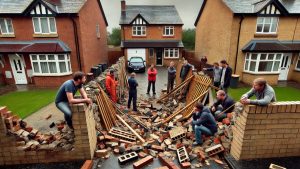
Repairing a collapsed boundary wall can be a significant financial burden, especially if the collapse involves a shared wall or has caused damage to other properties. However, there are several cost-effective solutions available that can help reduce expenses without compromising on safety or quality. Below are some practical approaches you can consider:
1. Shared Responsibility and Costs
If the collapsed boundary wall is shared between two properties, one of the most cost-effective solutions is to split the repair costs with your neighbour. This can significantly reduce your financial burden, particularly if the repairs are extensive.
Engaging in open communication with your neighbour and agreeing on a fair division of costs can help you both avoid unnecessary legal disputes and expenses.
2. DIY Repairs
For minor collapses or damages, undertaking a DIY approach can be a cost-effective solution. If you have some experience in construction or repair work, you could consider fixing the wall yourself.
There are numerous online resources and guides available that offer step-by-step instructions on how to repair different types of boundary walls, such as brick, stone, or timber. However, make sure that any DIY work adheres to local building regulations and safety standards.
3. Reusing Existing Materials
Another way to lower repair costs is to reuse as many materials from the collapsed wall as possible. If the bricks, stones, or other materials are still in good condition, you can salvage them to reconstruct the wall.
This reduces the need to purchase new materials and also preserves the aesthetic continuity of the boundary. Always inspect the reused materials for cracks or damage before incorporating them into the repair.
4. Affordable Building Materials
If reusing old materials is not an option, consider opting for more affordable alternatives. For instance, concrete blocks or prefabricated panels are often cheaper than bricks or natural stone and can be a viable option for boundary walls.
Similarly, treated timber can serve as a cost-effective material, particularly for fencing or partitioning walls, though it may not last as long as brick or stone.
5. Hiring Local Contractors
Hiring a local contractor or builder can save you money on transportation and material costs. Local contractors may also have established relationships with suppliers, which could help secure better prices for materials.
Additionally, sourcing a contractor through personal recommendations or local community boards may result in lower quotes compared to large construction firms.
6. Negotiating Payment Plans
If the cost of repairs is substantial, negotiating a payment plan with the contractor can make the expense more manageable. Many contractors offer flexible payment schedules that allow you to pay in instalments, reducing the immediate financial impact. Make sure to get any payment agreements in writing to avoid misunderstandings.
7. Government Grants or Insurance
In some cases, you may be eligible for government grants or financial assistance for boundary wall repairs. For instance, if the wall collapse was caused by a natural disaster like flooding or storms, there may be local or national schemes available to help with repair costs.
Additionally, check whether your home insurance policy covers the collapse. Even if the policy doesn’t cover general wear and tear, it might cover the damage caused by weather-related incidents.
8. Preventative Maintenance
One of the best cost-effective solutions is preventative maintenance. Regularly inspecting your boundary wall for signs of wear and tear, such as cracks, leaning, or erosion, can help you address minor issues before they turn into major repairs.
Early intervention often requires less extensive work and lower costs compared to waiting until the wall collapses.
Table: Comparison of Cost-effective Solutions for Boundary Wall Repairs
| Solution | Cost-saving Potential | Pros | Cons |
| Shared Repair Costs | High | Reduces individual expense | Requires neighbour cooperation |
| DIY Repairs | Moderate to High | No labour costs, full control | Requires skills, potential regulatory issues |
| Reusing Existing Materials | Moderate | Reduces material costs | May compromise on quality |
| Affordable Building Materials | Moderate | Cheaper material options like concrete | May have shorter lifespan |
| Hiring Local Contractors | Moderate | Lower transport and material costs | Requires negotiation for fair pricing |
| Negotiating Payment Plans | Moderate | Flexible payments reduce financial strain | May increase total cost due to extended terms |
| Government Grants/Insurance Claims | High (if eligible) | Financial relief from external sources | Limited eligibility and complex application |
| Preventative Maintenance | High (long-term savings) | Prevents costly future repairs | Requires regular inspections and upkeep |
Home Insurance and Boundary Wall Collapse
Homeowners should also consider how their insurance policies handle boundary wall collapses. Depending on the cause of the collapse and the terms of your policy, your insurance may cover the cost of repairs.
- Check your policy: Many home insurance policies cover damage to boundary walls caused by events like storms, floods, or falling trees. However, they may not cover collapses due to neglect, poor maintenance, or gradual wear and tear. Review your policy documents carefully to see what is covered.
- Natural disasters: If the wall collapses due to a natural event, such as a storm or flood, you may be able to claim the cost of repairs on your home insurance. However, insurers may require evidence that the collapse was not due to neglect.
- Neglect and maintenance issues: If the collapse is due to poor maintenance, your insurance company may refuse to cover the cost of repairs. This highlights the importance of regular maintenance to avoid costly repairs and insurance disputes.
What Are the Consequences of Ignoring a Collapsed Boundary Wall?
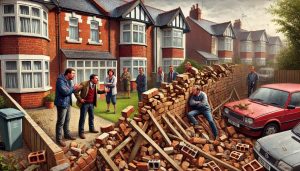
Ignoring a collapsed boundary wall can lead to serious consequences for both property owners. Here are a few potential risks:
- Legal action: If the collapse causes damage to neighbouring properties, you could be held legally responsible for any resulting damage. This could lead to expensive legal disputes and compensation claims.
- Financial costs: The longer a collapsed wall is left unrepaired, the more costly it may become to fix. Further damage could occur, and structural issues may worsen, leading to higher repair costs in the future.
- Neighbour relations: Leaving a collapsed boundary wall unaddressed can also strain your relationship with your neighbours, potentially leading to conflicts and long-term tensions.
- Property value: A collapsed boundary wall can negatively impact your property’s value, especially if it remains unrepaired for an extended period.
Conclusion
When a boundary wall collapses, it’s vital to address the issue promptly and fairly to avoid costly legal disputes and maintain good relations with your neighbours.
By understanding your responsibilities, knowing how to interpret property deeds and Party Wall Agreements, and staying informed about UK property laws, you can navigate boundary wall collapses with confidence. Timely communication with neighbours and, if necessary, seeking legal advice can also help resolve any disputes that arise.
FAQ Boundary Wall Collapses
What if both neighbours deny responsibility for the collapsed boundary wall?
If both neighbours deny responsibility, check the property deeds and title plans to determine ownership. If it’s a shared boundary, you may need to discuss a fair repair plan or seek mediation.
Can I force my neighbour to repair a shared boundary wall?
You cannot force your neighbour to repair a shared wall without legal action, but mediation or legal advice can help resolve the issue if they refuse to contribute.
How do I know which boundary wall is mine?
Property deeds or title plans will show who owns which boundary. You can obtain these from the Land Registry.
Are Party Wall Agreements mandatory in the UK?
Party Wall Agreements are not mandatory, but they are advisable when making alterations to a shared boundary wall to avoid disputes.
What happens if my boundary wall collapses and causes damage to my neighbour’s property?
If your boundary wall collapses and damages your neighbour’s property, you may be legally liable for the damage, especially if the collapse was due to neglect.
Can I get legal help for boundary disputes in the UK?
Yes, a solicitor specialising in property law can provide advice and help resolve disputes if communication or mediation fails.
Does my home insurance cover boundary wall collapses?
It depends on the policy. Many home insurance policies cover damage caused by natural events but exclude damage due to poor maintenance.

